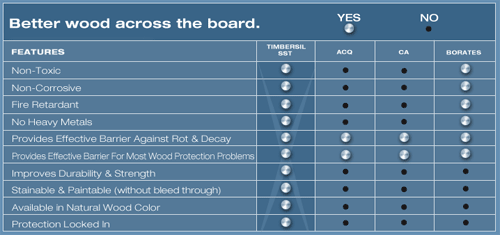
Two years ago, the EPA banned chromated copper arsenate (CCA) in pressure-treated wood for residential use because it deemed the chemical too toxic. It was soon replaced by alkaline (or amine) copper quat (ACQ) and copper azole (CA), two chemicals that are somewhat less toxic, but still require those handling and cutting treated wood to wear gloves and dust mask. In addition, the new chemicals are so corrosive to aluminum and steel that normal fasteners can’t be used with them. Clearly, this was not much of an improvement, which only makes one wonder why someone hasn’t come up with a much better solution.
Someone has. It is called TimberSIL, and is a revolutionary wood treatment barrier process that eliminates the problems typical of its predecessors. The result is treated wood that is environmentally friendly, nontoxic, non-carcinogenic, non-corrosive, and whose protective characteristics match or exceed those of many other treatment chemicals combined. It seemed too good to be true, so I called Bill Beard, one of the three owners of Timber Treatment Technologies, TimberSIL’s parent company, to find out more.
“TimberSIL is the only nontoxic process designed to protect against rot, decay and other common wood problems,” Bill told me, explaining that the difference comes not simply from replacing one poison with another, but by taking a different approach entirely. “Other CCA replacements are copper-based, corrosive, and must contain poisonous fungicides. In contrast, TimberSIL is not a preservative; it’s a protectant. A preservative is a pesticide and, as a result, is toxic. We create a protective barrier, effectively removing the food source, in this case, wood, from whatever might want to eat it.”
“The end result is actually more effective than the toxic treatments. We have a 40-year warranty on our wood against rot and decay, even for wood below the soil line. There are other advantages as well. Unlike copper-based treatments, the wood does not change color due to the treatment. You can stain it, finish it, paint it, and you can use it indoors, something you can’t do with other pressure-treated woods. It’s also nontoxic to plants, so it is great for planters, and can even be used for food contact items.”
How is it done? The secret is sodium silicate, a common, watersoluble, nontoxic material that has been used in water treatment plants as a corrosion inhibitor, as a replacement for phosphates in detergent, and even in paper manufacture. We come in contact with it every day. “We are simply using it in a different way for a different application,” Bill pointed out.
“We put sodium silicate into the wood and use an energy source to convert it. The liquid turns into an insoluble, amorphous, flexible glass just molecules thick that surrounds and protects the wood fibers. In short, it provides a protective barrier against the elements.”
If sodium silicate, or potassium silicate, sounds vaguely familiar to you, don’t be surprised. Potassium silicate, also called “water glass,” is commonly used to waterproof basements, and some violin makers use it on their plate woods. In fact, there is evidence of water glass in some very valuable 300-year-old violins.
The inventor of TimberSIL is Karen Slimak, who, along with Bill Beard and Ron Hobbs, formed Timber Treatment Technologies just two years ago. Bill and Ron both have long histories in the wood coatings and wood treatment industry, while Karen is an environmental toxicologist and a prolific inventor. Apparently, she came up with the TimberSIL process while looking for a fire retardant process for wood. If that’s not the perfect definition of serendipity, I don’t know what is.
As good as it is, don’t expect to see TimberSIL treated lumber at the local store just yet. It’s still too new. The company just recently formed an agreement with a primary distributor, Huttig, which has plans for a limited rollout in select areas this spring. Chances are, it will be at least 2007 before you see it all across the country.
Nevertheless, Beard is excited, and looks forward to revolutionizing the treated wood industry. “We feel that we are poised to become a major player in the field of protecting wood.”
As for me, I simply feel relieved that someone has come up with a safe alternative to pressure-treated wood that really does cover all the bases. Thanks, Karen.





